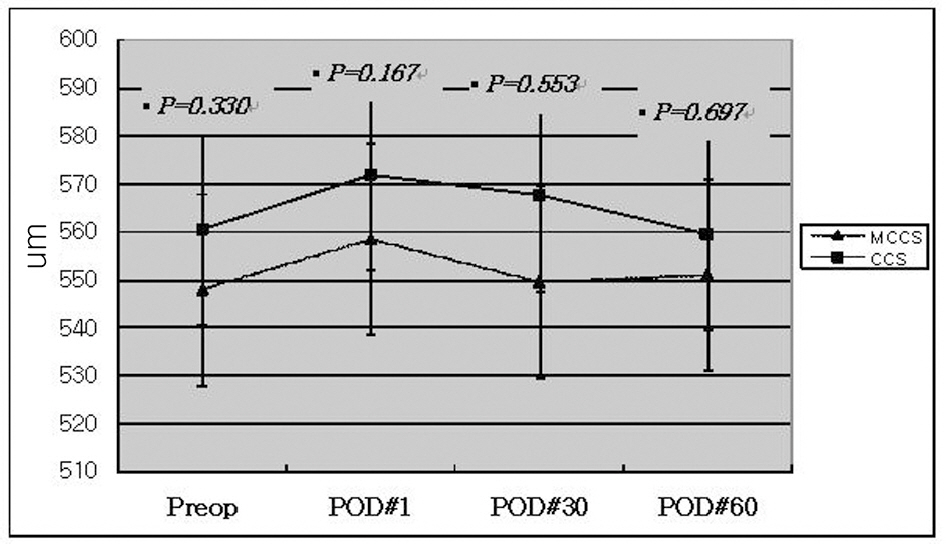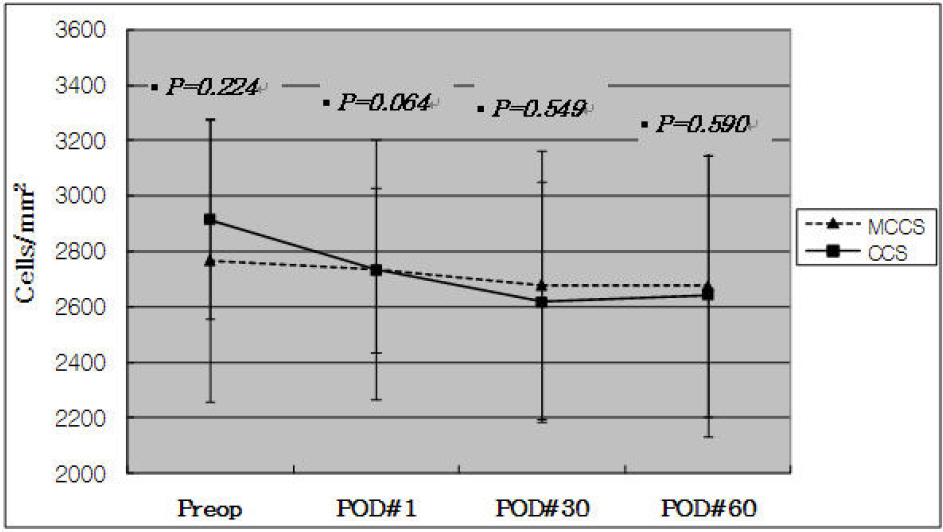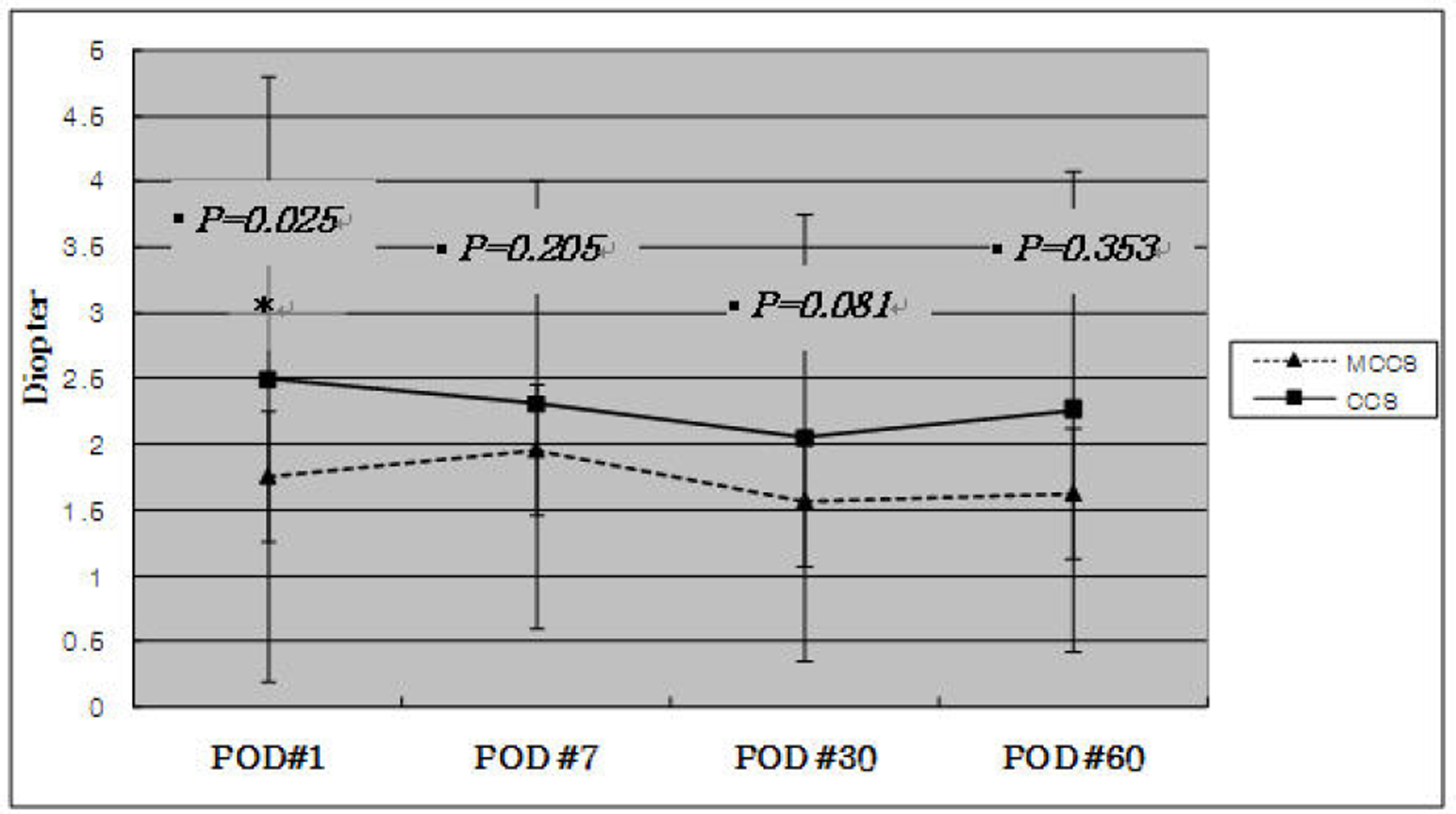Comparative Study of Microcoaxial Cataract Surgery and Conventional Cataract Surgery
- Affiliations
-
- 1Department of Ophthalmology and Visual Science, Catholic University of Korea, St. Mary's Hospital, Seoul, Korea. sara514@catholic.ac.kr
- KMID: 2110870
- DOI: http://doi.org/10.3341/jkos.2008.49.6.904
Abstract
-
PURPOSE: To compare the postoperative results of 2.2 mm microcoaxial cataract surgery (MCCS) and conventional 3.0 mm cataract surgery (CCS).
METHODS
This study included 30 patients (40 eyes): 17 patients (21 eyes) had microcoaxial cataract surgery using a 2.2 mm microcorneal incision, and 13 patients (19 eyes) had conventional cataract surgery using a 3.0 mm corneal incision. In these two groups, we measured phacoemulsification time, total phacoemulsification percentage, and effective phacoemulsification time (EPT) during cataract surgery. We compared corneal thickness, endothelial cell count, uncorrected visual acuity, best corrected visual acuity, and surgically, induced astigmatism (SIA) by corneal topography between the two groups preoperatively and at 1 day, 1 week, 1 month, and 2 months postoperatively.
RESULTS
There were significantly lower SIA (p=0.025) at postoperative day 1 in MCCS, and there was no significant difference after that. No difference in phacoemulsification time, total phacoemulsification percentage, EPT, corneal thickness, postoperative uncorrected visual acuity or corrected visual acuity was noted between MCCS and CCS.
CONCLUSIONS
MCCS using a 2.2 mm small corneal incision appears to be a safe and advanced procedure with a smaller amount of surgically-induced astigmatism during the early postoperative period.
Keyword
MeSH Terms
Figure
Cited by 6 articles
-
Comparison of Clinical Results between 2.2 mm MCCS and 2.8 mm SICS
Jung-Won Park, Jae-Kap Cho, Hyeon-Ju Nah, Yeoung-Geol Park, Kyung-Chul Yoon
Chonnam Med J. 2010;46(1):56-61. doi: 10.4068/cmj.2010.46.1.56.Comparison of Visual Function Between Two Aspheric Intraocular Lenses After Microcoaxial Cataract Surgery
Gui Hyeong Mun, Seong Kyu Im, Hong Yong Park, Kyung Chul Yoon
J Korean Ophthalmol Soc. 2010;51(3):333-339. doi: 10.3341/jkos.2010.51.3.333.Comparison of Clinical Results Between Two Spherical Aberraion-Free Intraocular Lenses
Gui Hyeong Mun, Seong Kyu Im, Hong Yong Park, Kyung Chul Yoon
J Korean Ophthalmol Soc. 2010;51(5):670-676. doi: 10.3341/jkos.2010.51.5.670.Influences on Astigmatism and Corneal Endothelium Using Two Different Incision Sizes and Mode of Phacoemulsification
Kyung Sup Shin, Jong Eun Lee, Si Hwan Choi
J Korean Ophthalmol Soc. 2013;54(2):237-244. doi: 10.3341/jkos.2013.54.2.237.Effects of Axial Length and Vitrectomy on Refractive Error after Cataract Surgery Using SRK/T Formula
Min Kyu Lee, Kyu Yeon Hwang, Man Soo Kim
J Korean Ophthalmol Soc. 2013;54(2):257-264. doi: 10.3341/jkos.2013.54.2.257.The Morphological Changes in Main Corneal Incision (2.2 mm vs. 2.8 mm) Evaluated Using Anterior Segment Optical Coherence Tomography
Jin Hyung Kim, Tae Im Kim, Eung Kweon Kim, Hyung Keun Lee
J Korean Ophthalmol Soc. 2013;54(6):877-886. doi: 10.3341/jkos.2013.54.6.877.
Reference
-
References
1. Kellman CD. Phacoemulsification and aspiration; a new technique of cataract removal; a preliminary report. Am J Ophthalmol. 1967; 64:23–35.2. Crema AS, Walsh A, Tamane Y, Nose W.Comparative study of coaxial phacoemulsification and microincision cataract surgery. One-year follow-up. J Cataract Refract Surg. 2007; 33:1014–8.3. Ku CH, Kim HJ, Joo CK. The comparison of astigmatism according to the incision size in small incision cataract surgery. J Korean Ophthalmol Soc. 2005; 46:416–21.4. Jee DH, Lee PY, Joo CK. The comparison of astigmatism according to the incision size in cataract operation. J Korean Ophthalmol Soc. 2003; 44:594–8.5. Vasavada V, Vasavada V, Raj SM, Vasavada AR. Intraoperative performance and postoperative outcomes of microcoaxial phacoemulsification: Observational study. J Cataract Refract Surg. 2007; 33:1019–24.6. Osher RH. Miacocoaxial phacoemulsification Part 2: clinical study. J Cataract Refract Surg. 2007; 33:408–12.7. Cavallini GM, Campi L, Masini C. . Bimanual microphacoemulsification vs coaxial miniphacoemulsification: Prospective study. J Cataract Refract Surg. 2007; 33:387–92.8. Fine IH, Packer M, Hoffman RS. Power modulations in new phacoemulsification technology: improved outcomes. J Cataract Refract Surg. 2004; 30:1014–9.9. Cravy TV. Calculation of the change in corneal astigmatism following cataract extraction. Ophthalmic Surg. 1979; 10:38–49.10. Huang FC, Teng SH. Compression of surgically induced astigmatism after sutureless temporal clear corneal and slceral frown incision. J Cataract Refract Surg. 1998; 24:477–81.11. Lee DS, Joo CK. Effect of incision length on visual recovery and astigmatism in no-suture cataract surgery. J Korean Ophthalmol Soc. 1992; 33:1036–42.12. Hu YJ, Joo CK. Surgically induced astigmatism after temporal clear corneal incision in sutureless cataract surgery. J Korean Ophthalmol Soc. 1998; 39:2622–7.13. Kim HJ, Kim JH, Lee DH. Endothelial cell damage in microincision cataract surgery and coaxial phacoemulsification. J Korean Ophthalmol Soc. 2007; 48:19–26.14. Alió J, Rodriguez-Prats JL, Galal A, Ramzy M. Outcomes of microincision cataract versus coaxial phacoemulsification. Ophthalmology. 2005; 112:1997–2003.15. Hayashi K, Hayashi H, Nakao F, Hayashi F. Risk factors for corneal endothelial injury during phacoemulsification. J Cataract Refract Surg. 1996; 22:1079–84.
Article16. Dick HB, Kohnen T, Jacobi FK, Jacobi KW. Long-term endothelial cell loss following phacoemulsification through a temporal clear corneal incision. J Cataract Refract Surg. 1996; 22:63–71.
Article17. Joussen AM, Barth U, Cubuk H, Koch H. Effect of irrigating solution and irrigation temperature on the cornea and pupil during phacoemulsification. J Cataract Refract Surg. 2000; 26:392–7.
Article18. Bourne RR, Minassian DC, Dart JK. . Effect of cataract surgery on the corneal endothelium; modern phacoemulsification compared with extracapsular cataract surgery. Ophthalmology. 2004; 111:679–85.19. Suzuki H, Takahashi H, Hori J. . Phacoemulsification associated corneal damage evaluated by corneal volume. Am J Ophthalmol. 2006; 142:525–8.
Article20. Wilczynski M, Drobniewski I, Synder A, Omulecki W. Evaluation of early corneal endothelial cell loss in bimanual microincision cataract surgery (MICS) in comparison with standard phacoemulsification. Eur J Ophthalmol. 2006; 16:798–803.
Article21. Mencucci R, Ponchietti C, Virgili G. . Corneal endothelial damage after cataract surgery: microincision versus standard technique. J Cataract Refract Surg. 2006; 32:1351–4.
Article22. Kahraman G, Amon M, Franz C. . Intraindividual comparison of surgical trauma after bimanual microincision and conventional small-incision coaxial phacoemulsification. J Cataract Refract Surg. 2007; 33:618–22.
Article23. Kurz S, Krummenauer F, Gabriel P. . Biaxial microincision versus coaxial small-incision clear cornea cataract surgery. Ophthalmology. 2006; 113:1818–26.
Article
- Full Text Links
- Actions
-
Cited
- CITED
-
- Close
- Share
- Similar articles
-
- Surgically Induced Posterior Corneal Astigmatism in 2.2 mm Microcoaxial Cataract Surgery Versus 2.85 mm Coaxial Conventional Cataract Surgery
- Surgically Induced Astigmatism and Corneal Higher Order Aberrations in Microcoaxial and Conventional Cataract Surgery
- One-Year Outcome of Microcoaxial Cataract Surgery Using 1.8 mm and 2.2 mm Incisions Versus that of Conventional Cataract Surgery
- Comparison of Clinical Outcomes Between Torsional Phacoemulsification of Infiniti(R) and Longitudinal Phacoemulification of Stellaris(R) Through 2.2 mm Microincision
- Comparison of Effective Phacoemulsification Time between Femtosecond Laser-Assisted Cataract Surgery and Conventional Cataract Surgery




